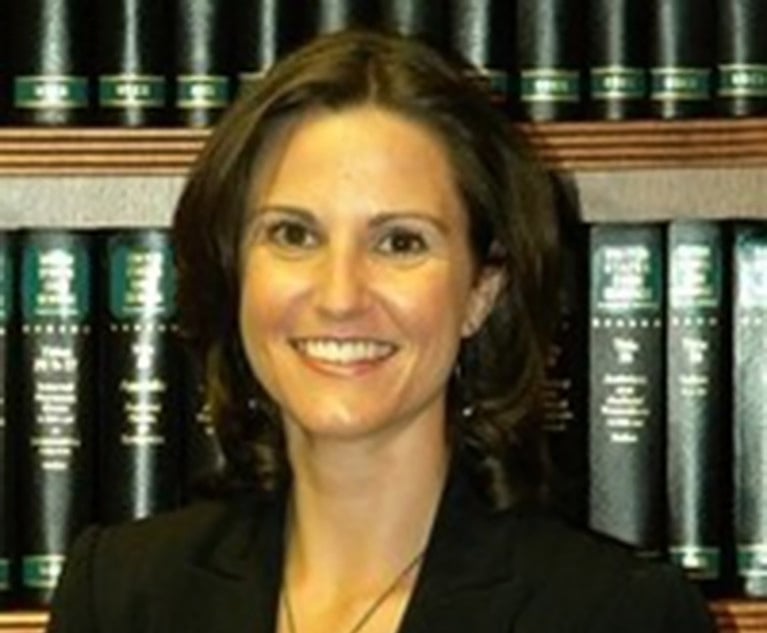Court Issues Three Major Insurance Rulings, Sets the Stage for Next Term
The New York Court of Appeals decided three important insurance cases in its 2018-2019 term. The Court also began to arrange its insurance caseload for next term by accepting a certified question from the U.S. Court of Appeals for the Second Circuit and by granting leave to appeal in another case.
August 16, 2019 at 02:15 PM
10 minute read
 The New York Court of Appeals decided three important insurance cases in its 2018-2019 term. Judge Rowan D. Wilson was the sole dissenter in the first two, with the Court reaching a unanimous decision in the third, and most significant, of the trio. The Court also began to arrange its insurance caseload for next term by accepting a certified question from the U.S. Court of Appeals for the Second Circuit and by granting leave to appeal in another case.
The New York Court of Appeals decided three important insurance cases in its 2018-2019 term. Judge Rowan D. Wilson was the sole dissenter in the first two, with the Court reaching a unanimous decision in the third, and most significant, of the trio. The Court also began to arrange its insurance caseload for next term by accepting a certified question from the U.S. Court of Appeals for the Second Circuit and by granting leave to appeal in another case.
Additional Compensation
In December, the Court decided Matter of Mancini v. Office of Children and Family Services, 32 N.Y.3d 521 (2018), which involved Workers’ Compensation Law (WCL) §15(3)(v) (Paragraph V), which permits certain permanently partially disabled workers who have exhausted their schedule awards to apply for “additional compensation.”
The case arose in 2008, when Steven Mancini was injured while working as an aide at a facility run by the Office of Children & Family Services (OCFS). A workers’ compensation law judge (WCLJ) found that Mancini had suffered a 50% loss of use of his left arm and, therefore, that he was entitled to a 156-week “schedule loss of use” award pursuant to WCL §15(3)(a)-(u), the statutory schedule providing wage-based compensation for permanent partial disability arising from injury to certain body parts and for serious facial or head disfigurement.
When Mancini’s schedule loss of use award was exhausted, he applied for and was awarded additional compensation under Paragraph V. Paragraph V incorporates by reference WCL §15(3)(w) (Paragraph W), stating that additional compensation under Paragraph V “shall be determined in accordance with [P]aragraph [W].”
At the hearing on Mancini’s application, an issue arose regarding which portions of Paragraph W’s framework for calculating benefits applied to an additional compensation award under Paragraph V.
The WCLJ determined that Paragraph V incorporated only the Paragraph W formula for determining the sum of each weekly payment and not the portion of Paragraph W stating the number of weeks the benefits were to be awarded.
The workers’ compensation board rejected that interpretation, however, and concluded that Paragraph W’s durational limits applied to additional compensation awards under Paragraph V. After further proceedings, the board ultimately determined that Mancini lost 37.5% of his wage-earning capacity and was entitled, based on the Paragraph W calculation, to 275 weeks of additional compensation under Paragraph V due to the injury to his arm.
The Appellate Division, Third Department, affirmed, and the case reached the Court of Appeals. There, Mancini argued that Paragraph V incorporated only Paragraph W’s formula for calculating the weekly payment amount and not Paragraph W’s durational component setting forth the number of weeks that sum was paid. The board countered that Paragraph V incorporated by reference the entirety of Paragraph W’s framework for calculating benefits, including its durational limits.
The Court, in a decision by Chief Judge Janet DiFiore, agreed with the board.
The Court found that the “plain text” of Paragraph V adopted, without qualification, Paragraph W’s process for determining the size and scope of a disability award and incorporated the “entirety” of Paragraph W’s framework for calculating benefits, including both the Paragraph W formula “for determining a weekly benefit payment” and the portion of that provision “setting the maximum number of weeks” the sum was to be paid.
Accordingly, the Court concluded that the board had properly computed the additional compensation benefits payable to Mancini.
Judge Wilson dissented, explaining that in his view the durational provision of Paragraph W did not apply to the calculation of additional compensation under Paragraph V.
Risk Retention Groups
On June 11, the Court decided Nadkos, Inc. v. Preferred Contractors. Ins. Co. Risk Retention Group LLC, No. 37 (N.Y. June 11, 2019), which involved an insurance coverage dispute between Nadkos, Inc., a general contractor sued by an employee of a Nadkos subcontractor, and the subcontractor’s general liability insurer, a risk retention group (RRG) chartered in Montana and doing business in New York. An RRG is an issuer of insurance owned and operated by insureds that work in the same industry and that are exposed to similar liability risks.
Here, Nadkos sought additional insured coverage of the subcontractor’s employee’s lawsuit under the policy that the RRG had issued to the subcontractor.
After the RRG disclaimed coverage based on certain exclusions in the policy, Nadkos sought a declaratory judgment that the policy obligated the RRG to defend and indemnify Nadkos. Nadkos also maintained, without objection from the RRG, that the RRG’s disclaimer was untimely. As a result, Nadkos argued, the disclaimer was void under Insurance Law §3420(d)(2), which provides that if “an insurer shall disclaim liability or deny coverage … it shall give written notice as soon as is reasonably possible.”
The Supreme Court, New York County, granted summary judgment in favor of the RRG, the Appellate Division, First Department, affirmed, and the case reached the Court of Appeals.
The Court, in an opinion by Justice Jenny Rivera, affirmed. It held that foreign RRGs are not subject to §3420(d)(2) and its requirement that insurers “disclaim” liability as soon as is reasonably possible.
The Court reasoned that §3420(d)(2) does not apply to RRGs because it does not involve a failure to promptly “disclose” coverage within the meaning of Insurance Law §2601(a)(6), the statutory provision applicable to foreign RRGs.
Therefore, the Court concluded, the RRG was not barred from asserting coverage defenses as applied to Nadkos.
Justice Wilson once again dissented, declaring that §3420(d)(2) by its terms applied “to all liability insurers operating in this state,” including foreign RRGs and the policy the RRG had issued to Nadkos’ subcontractor.
Non-Physician-Owned Medical Providers
Also on June 11, the Court issued its decision in Andrew Carothers, M.D., P.C. v. Progressive Ins. Co., No. 39 (N.Y. June 11, 2019), the insurance decision with the most significant practical implications from this past term because it strengthened the ability of insurers to refuse to pay claims submitted by medical providers secretly owned by non-physicians in violation of New York’s prohibition of the corporate practice of medicine.
The case involved Andrew Carothers, M.D., P.C., a professional service corporation formed in 2004 by Andrew Carothers, M.D., a radiologist. The PC provided magnetic resonance imaging services to patients, including those allegedly injured in motor vehicle accidents. The patients assigned their rights to receive first-party no-fault insurance benefits to the PC, which billed insurance companies to recover payment on the assigned claims.
Insurance companies stopped paying the PC’s no-fault claims in 2006 and the PC sued.
The insurers asserted that, under State Farm Mutual Automobile Ins. Co. v. Mallela, 4 N.Y.3d 313 (2005) (a case in which my firm and I were co-counsel for State Farm), and 11 N.Y.C.R.R §65-3.16(a)(12), the PC was not eligible to seek reimbursement of the insurance benefits because Carothers was merely a nominal owner of the PC and the PC actually was owned and controlled by individuals who were not physicians.
The PC asserted that Mallela allowed insurers to withhold payments under 11 NYCRR 65-3.16(a)(12) only where the professional corporation’s ostensible or real managers had engaged in conduct “tantamount to fraud,” which it claimed the insurers had not demonstrated.
A jury found that the insurers had proved that the PC was “fraudulently incorporated,” and, accordingly, not entitled to recover the payment it sought from the insurers. The case reached the Court of Appeals.
The Court, in a unanimous decision by Judge Eugene M. Fahey, upheld the decision in favor of the insurance companies. It ruled that Mallela does not require a finding of fraud for an insurer to withhold payments to a medical service corporation improperly controlled by non-physicians.
In particular, the Court ruled that, under Mallela and 11 NYCRR 65-3.16(a)(12), an insurance carrier need not demonstrate that a professional service corporation or its managers engaged in common law fraud in order to deny payment of no-fault benefits. Rather, the Court stated, a corporate practice that shows “willful and material failure to abide by” licensing and incorporation statutes may support a finding that the provider is not an eligible recipient of reimbursement under the no-fault rules.
The Court concluded that the jury’s finding that the PC was in material breach of the “foundational rule” for professional corporation licensure—that it violated the principle of control by licensed professionals—was enough to render the PC ineligible for reimbursement.
And for Next Term …
As noted above, the Court already has agreed to decide two insurance-related cases next term.
In March, in Haar v. Nationwide Mutual Fire Ins. Co., No. 48 (N.Y. March 21, 2019), the Court accepted a certified question from the Second Circuit in a case that began when an orthopedic surgeon sued an insurance company, alleging that the insurer had submitted a report about him in bad faith to the New York State Office of Professional Medical Conduct (OPMC). The surgeon asserted a cause of action for damages pursuant to Public Health Law §230(11)(b).
The U.S. District Court for the Southern District of New York dismissed the cause of action asserted by the surgeon under §230(11)(b), holding that the New York Court of Appeals, were it faced with the question, would find that the statute did not create a private right of action. Section 230(11)(b) states that “[a]ny person, organization, institution, insurance company, osteopathic or medical society who reports or provides information to the [state board for professional misconduct] in good faith, and without malice shall not be subject to an action for civil damages or other relief as the result of such report.”
The surgeon appealed, arguing that there was an implied cause of action under the statute for complaints made in bad faith to the OPMC. The Appellate Division, Second Department, has determined that there is no private right of action, while the Appellate Division, First Department, has reached the opposite result.
The Second Circuit asked the Court of Appeals to decide whether §230(11)(b) creates a private right of action for bad faith and malicious reporting to the OPMC.
Excess Insurance
Finally, in June, the Court granted the plaintiff leave to appeal in Chen v. Insurance Company of Pennsylvania, No. 2019-337 (N.Y. June 11, 2019).
In this case, the Court will consider questions related to the obligations of an excess carrier for interest on a judgment based on an excess policy that “follows form” to the underlying policy.
Conclusion
The Court’s decisions this past term on issues relating to workers’ compensation payments, risk retention groups, and no-fault insurance claims reflects the Court’s continuing interest in a wide range of insurance-related questions. That will continue next term, with the Court already having agreed to decide two cases involving other important insurance subjects.
Evan H. Krinick, managing partner of Rivkin Radler, is the Insurance Fraud columnist for the New York Law Journal. Mr. Krinick can be reached at [email protected].
This content has been archived. It is available through our partners, LexisNexis® and Bloomberg Law.
To view this content, please continue to their sites.
Not a Lexis Subscriber?
Subscribe Now
Not a Bloomberg Law Subscriber?
Subscribe Now
NOT FOR REPRINT
© 2025 ALM Global, LLC, All Rights Reserved. Request academic re-use from www.copyright.com. All other uses, submit a request to [email protected]. For more information visit Asset & Logo Licensing.
You Might Like
View All


Trending Stories
- 1States Accuse Trump of Thwarting Court's Funding Restoration Order
- 2Microsoft Becomes Latest Tech Company to Face Claims of Stealing Marketing Commissions From Influencers
- 3Coral Gables Attorney Busted for Stalking Lawyer
- 4Trump's DOJ Delays Releasing Jan. 6 FBI Agents List Under Consent Order
- 5Securities Report Says That 2024 Settlements Passed a Total of $5.2B
Who Got The Work
J. Brugh Lower of Gibbons has entered an appearance for industrial equipment supplier Devco Corporation in a pending trademark infringement lawsuit. The suit, accusing the defendant of selling knock-off Graco products, was filed Dec. 18 in New Jersey District Court by Rivkin Radler on behalf of Graco Inc. and Graco Minnesota. The case, assigned to U.S. District Judge Zahid N. Quraishi, is 3:24-cv-11294, Graco Inc. et al v. Devco Corporation.
Who Got The Work
Rebecca Maller-Stein and Kent A. Yalowitz of Arnold & Porter Kaye Scholer have entered their appearances for Hanaco Venture Capital and its executives, Lior Prosor and David Frankel, in a pending securities lawsuit. The action, filed on Dec. 24 in New York Southern District Court by Zell, Aron & Co. on behalf of Goldeneye Advisors, accuses the defendants of negligently and fraudulently managing the plaintiff's $1 million investment. The case, assigned to U.S. District Judge Vernon S. Broderick, is 1:24-cv-09918, Goldeneye Advisors, LLC v. Hanaco Venture Capital, Ltd. et al.
Who Got The Work
Attorneys from A&O Shearman has stepped in as defense counsel for Toronto-Dominion Bank and other defendants in a pending securities class action. The suit, filed Dec. 11 in New York Southern District Court by Bleichmar Fonti & Auld, accuses the defendants of concealing the bank's 'pervasive' deficiencies in regards to its compliance with the Bank Secrecy Act and the quality of its anti-money laundering controls. The case, assigned to U.S. District Judge Arun Subramanian, is 1:24-cv-09445, Gonzalez v. The Toronto-Dominion Bank et al.
Who Got The Work
Crown Castle International, a Pennsylvania company providing shared communications infrastructure, has turned to Luke D. Wolf of Gordon Rees Scully Mansukhani to fend off a pending breach-of-contract lawsuit. The court action, filed Nov. 25 in Michigan Eastern District Court by Hooper Hathaway PC on behalf of The Town Residences LLC, accuses Crown Castle of failing to transfer approximately $30,000 in utility payments from T-Mobile in breach of a roof-top lease and assignment agreement. The case, assigned to U.S. District Judge Susan K. Declercq, is 2:24-cv-13131, The Town Residences LLC v. T-Mobile US, Inc. et al.
Who Got The Work
Wilfred P. Coronato and Daniel M. Schwartz of McCarter & English have stepped in as defense counsel to Electrolux Home Products Inc. in a pending product liability lawsuit. The court action, filed Nov. 26 in New York Eastern District Court by Poulos Lopiccolo PC and Nagel Rice LLP on behalf of David Stern, alleges that the defendant's refrigerators’ drawers and shelving repeatedly break and fall apart within months after purchase. The case, assigned to U.S. District Judge Joan M. Azrack, is 2:24-cv-08204, Stern v. Electrolux Home Products, Inc.
Featured Firms
Law Offices of Gary Martin Hays & Associates, P.C.
(470) 294-1674
Law Offices of Mark E. Salomone
(857) 444-6468
Smith & Hassler
(713) 739-1250







